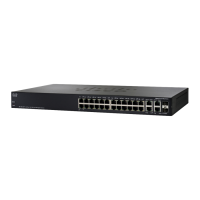Configuring Discovery
Configuring LLDP
Cisco Small Business 300 Series Managed Switch Administration Guide 67
8
4. Associate LLDP MED network policies to ports by using the
LLDP MED Port
Settings Page
.
5. View LLDP local port status details by using the
LLDP Local Information Page.
6. View the LLDP information that was discovered from neighbors, such as local
port, system name, time to live, system description, system capabilities by using
the
LLDP Neighbors Information Page
.
7. View LLDP-related statistical information per interface by using the
LLDP
Statistics Page
.
8. Display overloading information by using the
LLDP Overloading Page
.
Setting LLDP Properties
The
LLDP Properties Page
enables entering LLDP general parameters. These
include enabling/disabling the feature globally and setting timers.
To enter LLDP properties:
STEP 1 Click Administration > Discovery - LLDP > Properties. The LLDP Properties
Page opens.
STEP 2 Enter the parameters.
• LLDP Status—Select the LLDP global status on the switch.
• TLV Advertise Interval—Enter the rate in seconds at which LLDP
advertisement updates are sent.
• Topology Change SNMP Notification Interval—Enter the minimum time
interval between SNMP notifications.
• Hold Multiplier—Enter the amount of time that LLDP packets are held before
the packets are discarded, measured in multiples of the TLV Advertise
Interval. For example, if the TLV Advertise Interval is 30 seconds, and the
Hold Multiplier is 4, then the LLDP packets are discarded after 120 seconds.
• Reinitializing Delay—Enter the time interval in seconds that passes
between disabling and reinitializing LLDP, following an LLDP enable/disable
cycle.
• Transmit Delay—Enter the amount of time in seconds that passes between
successive LLDP frame transmissions due to changes in the LLDP local
systems MIB.

